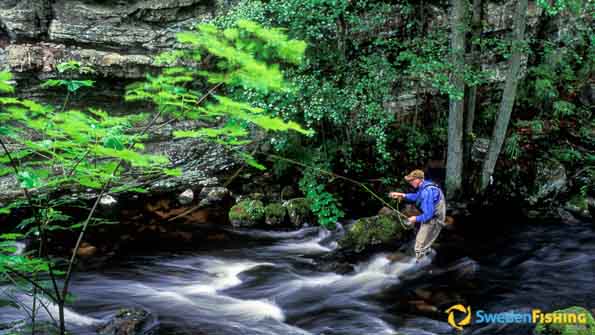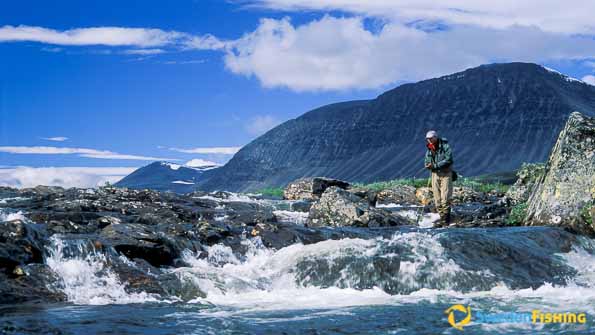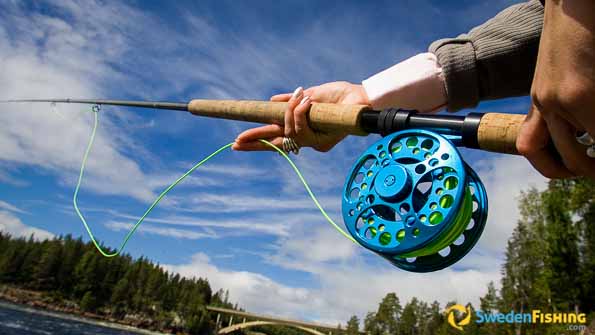Species and fishing opportunities in northern Sweden
For anyone seeking silence and immense spaces, the alpine world of northern Sweden is a fulfilment. Up here north of the Arctic Circle lies the last wilderness in Europe offering world-class fishing for brown trout and char and even pike. Excellent roads with few cars, night trains, bus lines, international flight connections with SAS or Norwegian or charter all combine to make a fishing trip to Norrland a pleasure.
The northern parts of Sweden can be divided on an east-west axis into two parts differing mainly in altitude and ecosystems and thus also in climate. The western area bordering on Norway comprises the Scandinavian alpine region, a mountain range extending more than a thousand kilometres from Dalarna province in the south towards the Treriksröset – Three Country Cairn – where Finland, Norway and Sweden meet. The highest mountain is Kebnekaise (2102 m). Most of the range lacks roads and has few or no residents. However, there are smaller communities in some of the alpine valleys with roads, some of which lead into Norway.

Everyone ought to have a chance to hike and fish in the Swedish alpine region.
Winter arrives earlier here, often descending in October and lasting into May. In the eastern forests winter comes a month later and spring a month earlier. “The entire alpine region and the nearby woods abound in fishing waters, most offering great trout, char and grayling fishing,” according to Sven. “The most difficult part is not finding good waters, but getting there. Today, however, many fishing transports into the alpine region use helicopters.”
Anna explains that fish domination depends at least to some extent on what waters are being fished. “A general rule is that char tends to take over the higher the altitude, while grayling does not go as high as either trout or char.”
“While all three species can be worked using different methods, fly fishing is the most common,” according to Anna. “Since all three feed mainly on insects, different types of dry and wet flies are called for. Except, of course, for the large brown trout and chars that eat other fish. Sometimes you’ll find char circling the most delicately presented flies while completely refusing to bite.”

Crystal clear waters you can drink are but one experience more besides the fantastic grayling, char
and trout fishing.
Unpredictable chars
Shaking his head, Sven agrees: “I can’t think how often I’ve thought I’d go nuts when a school of char refused to bite…,” and Anna breaks in: “… and only three hours later the same fish will attack everything you tie on the snood. But then that’s the charm of fishing for char.”
There are brown trout in many waters, both running and still. The largest fishes are caught in the latter or in streams that either empty into or run through larger lakes. They bite on many different lures, but for the giants, you need smaller wobblers or larger streamer-type flies.
Anna adds that “char is the perfect dry-fly fish rising to the surface to eat regardless of weather and wind. Dry-fly fishing for char in the eddies of a running stream under the midnight sun is an experience everyone should have.”
Those who do not fly fish can often use a light spinning rod. This can even be advantageous when the weather is down, with higher water levels as a logical result. Sven goes further: “Load your lure box set of small spinners and spoons in various nuances, some small wobblers in varied colours and add in some jigs.” Another tip is to replace all triple hooks with singles to make it easier to return the fish without wounding it.

In the forested area of northern Sweden many lakes offers good fishing for pike, brown trout,
grayling and perch.
Below the alpine region to the east lies the forested plain reaching to the Gulf of Bothnia. It is crossed by a number of alpine rivers that empty into the gulf and up which both salmon and sea trout run. Some of the better known salmon waters are the Torneälven, Kalixälven, Kaitumälven, Byskeälven and Lödgeälven Rivers. Basically both fishes run up all rivers in northern Sweden, differing only in how high they go. Both leave the gulf in the early summer and continue from June into August. Thus July is the best month for salmon and sea trout fishing.
“But as we travel into the forests we mustn’t forget the pike,” suggests Anna. “There are thousands of superb pike waters here, in much unused and waiting to be discovered!” In the northern area pike has long been neglected in favour of the salmon-like fishes with few realizing their value as a sports fish. Sven agrees here as well: “Except for salmon, there is no Swedish species that grows as large, strong and eager to bite as the pike. Since the water temperature up here is at the right level most of the season, we find pike in shallow water where it is easy to get to. Depending on where in northern Sweden you are and with some annual variations, you can fish pike in ice-free waters from May through June until September or October.”
Using worms illegal
At one time using worms in running water was a common method, but that is no longer legal. The reason is that the fish is usually hooked far down in the throat making it very hard to return it without damage.
-
Northern Sweden is an enormous land area with uncounted lakes, rivers and jokks, Sami for creek,...
-
Northern Sweden and what in common parlance is called Lapland is an immense area embracing a thir…
-
For anyone seeking silence and immense spaces, the alpine world of northern Sweden is a fulfilme…
Stories from north Sweden





